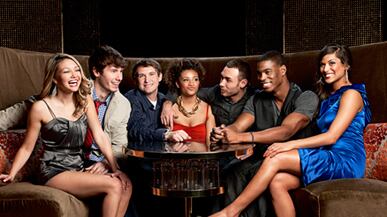Stop us if you’ve heard this one before: seven strangers have been picked to live in a house, and have their lives taped to find out what happens when people stop being polite, and start getting real. Yes, it’s time again for the premiere of The Real World, the MTV docu-soap credited with launching the modern reality television genre as we know it. It’s a show running as if on auto-pilot; no one seems to ever talk about it, its seasons come and go with little fanfare.

And yet, The Real World’s last season, its second visit to New Orleans, tallied an average viewership of around 2 million. Sure, it’s no record-shattering ratings behemoth like Jersey Shore (which does nearly triple RW’s number), but for a cable show entering its 25th season, The Real World is downright solid—as many people watch it as watch Mad Men. The question at this point isn’t what happens when people stop being polite and start getting real, it’s why so many people are still tuning in to find out.
The answer is that for all its faults, The Real World still commands a level of currency that's lacking from the slice-of-life reality shows it helped paved the way for. That's right, The Real World is still relevant. Granted, the show's formula has remained essentially unchanged since its premiere. A group of twentysomethings from disparate backgrounds is thrown together in a swanky house and not given much of anything to do, which typically results in aimless debauchery and the hot tub being used in ways that almost certainly voids the manufacturer's warranty. Those aspects are nothing a viewer couldn't get from Jersey Shore or Bad Girls Club—reality shows all about putting casts together based on how similar they are to one another. What's unique to The Real World is that it's the only show in which young people are put together and encouraged to discuss difference in substantive ways.
ADVERTISEMENT
In the show's early seasons, most notably the New York City-set first season and the San Francisco-set third, difference was a prominent theme, and the engine for much of the drama. Anyone who watched that first season probably still remembers the racially-charged confrontations between cast members Kevin Powell and Becky Blasband, or the unusual friendship that formed between Jersey b-girl Heather Gardner and country girl Julie Gentry. But it was the third season, which featured HIV-positive activist Pedro Zamora, which had the most lasting cultural impact. At a time when HIV was still a mystery to much of the country, Zamora's roommates educated themselves about the disease, and educated the country in the process.
Cast members are still put in a position that forces them to examine their identities in relation to their housemates, even if the conversations are a bit more subtle and often overshadowed by drunken drama.
Many seasons later, these aren't the sorts of moments for which audiences tune into The Real World, but the tackling of difference is still at the forefront of the show. "For a show like ours, that doesn't have a competition component, the diversity of our cast members is very critical to the story," the show’s co-creator, Jonathan Murray, told The Daily Beast. In the new season, the second to be shot in Las Vegas, the castmates come in expecting to have little in common. They find out later that in spite of their wildly different backgrounds, most of them are struggling with a relationship with an estranged parent, which shocks them based on their preconceptions of one another.
As for why those kinds of moments seem like they are crowded out by non-stop Jager shots and boob-flashing, Murray says his show has only reflected the way youth culture has changed. The types of charged racial or sexuality-based conversations that were once the show's bread-and-butter have decreased over time as young people have become more tolerant. "You don't see as much of that now because young people are not as focused on those things anymore. We’ve come a long way since the early '90s when The Real World came on, and issues like race just aren’t as big a deal for young people now, neither is sexual orientation. They take on people for who they are, how they act and what they say. The Real World has maybe played a small part in that."
But the difference still remains, and cast members are still put in a position that forces them to examine their identities in relation to their housemates, even if the conversations are a bit more subtle and often overshadowed by drunken drama. Trishelle Cannatella was part of the original Las Vegas cast, a season largely credited for cementing the show's move away from something earnest to something more sensationalist. But while her cast partied hard, Cannatella still remembers the experience for how much it took her out of her comfort zone and forced her to consider other points of view. "I didn’t have a lot in common with any of my housemates, and we all were raised completely differently," she said. "I was raised in a strict, Christian background and no one else in the cast came from that background, so it was shocking for me to meet someone who was an atheist, for example, and it was a huge learning experience for me then."
The Real World’s sustained ratings success is not because of its casts’ alcohol-fueled romps, but because at its core, it’s still the same show it always has been: one about kids from different backgrounds working through their differences and finding surprising commonalities along the way. Which is something you’ll never see out of Snooki. “ Jersey Shore is a great show, the characters are fun to watch, but those characters aren’t going to change or evolve much,” Murray says. “With The Real World, people still do evolve and change, and they are affected by being with each other. It’s just that they are affected in different ways. It’s not ‘I’m living with someone of a different race and how will that affect me, it’s more like ‘I’m living with someone who has a totally different background and different values than me.’”






